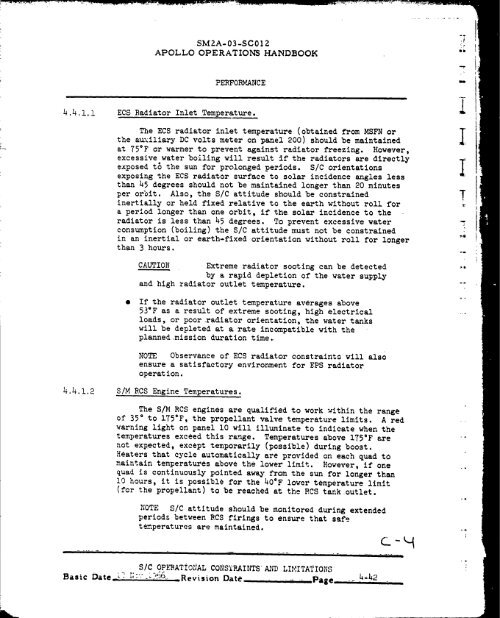Apollo 204 Review Board Appendix C Section 2 - NASA's History ...
Apollo 204 Review Board Appendix C Section 2 - NASA's History ...
Apollo 204 Review Board Appendix C Section 2 - NASA's History ...
Create successful ePaper yourself
Turn your PDF publications into a flip-book with our unique Google optimized e-Paper software.
SM2A-03-SC01Z<br />
APOLLO OPERATIONS HANDBOOK<br />
4.4.1.I ECS Radiator Inlet Temperature.<br />
PERFORY._NCE<br />
The ECS radiator inlet temperature (obtained from MSFN or<br />
the a_ciliary DC volts meter on panel 200) should be maintained<br />
at 75"F or warmer to prevent against radiator freezing. However,<br />
excessive water boiling will result if the radiators are directly<br />
exposed t6 the sun for prolonged periods. S/C orientations<br />
exposing the ECS radiator surface to solar incidence angles less<br />
than 45 degrees should not be maintained longer than 20 minutes<br />
per or_oit. Also, the S/C attitude should be constrained<br />
inertially or held fixed relative to the earth without roll for<br />
a period longer than one orbit, if the solar incidence to the<br />
radiator is less than 45 degrees. To prevent excessive water<br />
consumption (boiling) the S/C attitude must not be constrained<br />
in an inertial or earth-fixed orientation without roll for longer<br />
than 3 hours.<br />
CAUTION Extreme radiator sooting can be detected<br />
by a rapid depletion of the water supply<br />
and high radiator outlet temperature.<br />
• If the radiator outlet temperature averages above<br />
53@F as a result of extreme sooting, high electrical<br />
loads, or poor radiator orientation, the water tanks<br />
_ill be depleted at a rate incompatible with the<br />
planned mission duration time.<br />
NOTE Observance of ECS radiator constraints will als0<br />
ensure a satisfactory environment for EPS radiator<br />
operation.<br />
4.4.1.2 S/M RCS Engine Temperatures.<br />
The S/M RCS engines are qualified to work within the range<br />
of 35" to 175"F, the propellant valve temperature limits. A red<br />
warning light on panel l0 will illuminate to indicate when the<br />
temperatures exceed this r_nge. Temperatures above 175°F are<br />
not expected, except temporarily (possible) during boost.<br />
Heaters that cycle automatically are provided on each quad to<br />
maintain temperatures above the lower limit. However, if one<br />
quad is continuously pointed away from the sun for longer than<br />
I0 hours, it is possible for the h0"F lower temperature limit<br />
(for the propellant) to be reached at the RCS tank outlet.<br />
NOTE S/C attitude should be monitored during extended<br />
periodz between RCS firings to ensure that safe<br />
temperatures awe maintained.<br />
S/C OPE_ATIOItAL CONS'fI_._INTS AND LI_,'rTATIONS<br />
Basic Date_'L_ I;_v L'_6.. . Revision Date<br />
m_<br />
.L<br />
I<br />
i<br />
T<br />
as<br />
e ,
















